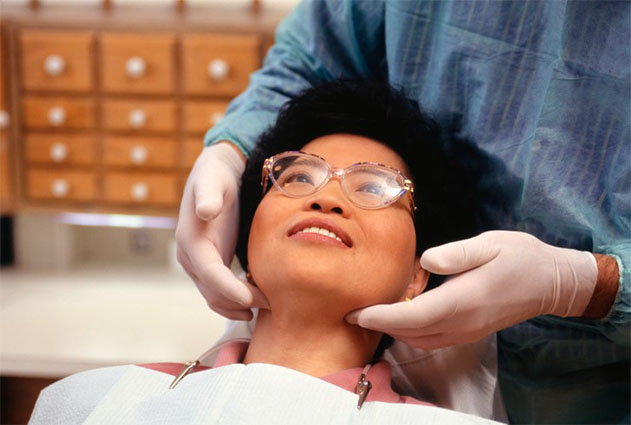
According to the American Cancer Society, around 54,000 cases of oral cavity were diagnosed in 2022. About 11,000 deaths were also attributed to oral cancers in this same timeframe. That’s around 25% of new cases! Unfortunately, awareness about oral cancers, their risks, and the causes for them isn’t as high as many dentists would like.
What is the best way to protect yourself against oral cancer and reduce your risk? See your dentist – regularly!
What Is Oral Cancer?
Oral cancer is uncontrollable growth of cells that invade and cause damage to surrounding tissue. Like many other cancers, it’s the result of DNA mutating and sending instructions for cells to grow and multiply even when it’s not needed and detrimental to other cells. Eventually, this growth can develop into a tumor. During this rapid growth, the cancer cells can spread to other areas, including around your head or your neck.
Specifically, oral cancers can occur in places like your lips, gums, tongue, cheeks and the top or bottom of your mouth. In some cases, these can be referred to as oral cavity cancer. In most cases of oral cancer, they start in thin cells known as squamous cells.
Doctors still aren’t sure what triggers the mutation leading to mouth cancers. It can be life threatening if not diagnosed and treated early. Thankfully, it is a relatively rare form of cancer, accounting less than 5% of all cancers in the United states.
Symptoms of oral cancer include:
- Swellings/thickenings, lumps or bumps, rough spots/crusts/or eroded areas on the lips, gums, or other areas inside the mouth
- The development of velvety white, red, or speckled (white and red) patches in the mouth
- Unexplained bleeding in the mouth
- Unexplained numbness, loss of feeling, or pain/tenderness in any area of the face, mouth, neck, or ear
- Persistent sores on the face, neck, or mouth that bleed easily and do not heal within 2 weeks
- A soreness or feeling that something is caught in the back of the throat
- Difficulty chewing or swallowing, speaking, or moving the jaw or tongue
- Hoarseness, chronic sore throat, or change in voice (especially slurred speech)
- A change in the way your teeth or dentures fit together
- Dramatic weight loss
- A lump in the neck
Why Is Oral Cancer Dangerous?
Oral cancer is a particularly dangerous cancer. This is because, unlike many other types of cancers, oral cancer often isn’t detected until it’s in its late stages. Like other cancers, early detection is one of the best identifiers for successful intervention. Unfortunately, not many people are in the habit of examining their mouth or throat unless they think something is wrong, and by that time, it’s often too late.
In most cases, without visiting the dentist for regular screening, oral cancers can remain undetected until they spread all the way to your lymph nodes. By this point, it’s often in its later stages and much more difficult to treat, if possible at all.
This is the likely explanation behind its high mortality rate. Moreover, many people continue to engage in lifestyle habits that contribute to oral cancer risks.
Who Is At Risk For Oral Cancer?
Some of the risk factors associated with oral cancer are controllable, others are not. Men tend to be at greater risk for developing oral cancer than women. Age is also a factor; most oral cancers are detected in people between 55 and 64 years old.
However, lifestyle also has an impact. These behaviors are known risk factors in increasing your chance of getting oral cancer:
- Using tobacco products
- Heavy alcohol use (drinking more than 4 drinks per day)
- Using alcohol and tobacco products together
- Eating a diet low in fruits and vegetables
- Spending long periods in the sun without sunscreen – especially for your lips
Also, individuals infected with HPV (human papilloma virus) are at greater risk for oral cancer, and their cancers tend to surface 4 to 10 years earlier than others who develop the disease.
How Can You Minimize Your Risk?
Regular dental visits are critical to detect symptoms early. As part of your routine dental exam, your dentist will conduct an oral cancer screening. More specifically, your dentist will feel for any lumps or irregular tissue changes in your neck, head, face, and oral cavity. When examining your mouth, your dentist will look for any sores or discolored tissue as well as check for any signs and symptoms mentioned above.
If your dentist finds unusual-looking tissue, he or she may perform an oral brush biopsy. This test is painless and involves taking a small sample of the tissue and analyzing it for abnormal cells. However, if the tissue looks more suspicious, your dentist may recommend a scalpel biopsy. This procedure usually requires local anesthesia and may be performed by your dentist or a specialist. These tests are necessary to detect oral cancer early, before it has had a chance to progress and spread.
Catching oral cancer early dramatically increases your chances of fighting back. Along with all the other benefits of regularly visiting the dentist, keeping yourself safe from cancer is a great reason to keep up with your visits every year!
Contact Walbridge Dental
Concerned about your risk for oral cancer? We can help. From routine cleaning and exams to advanced restorative treatments to oral cancer detection, the professionals at Walbridge Dental provide complete family dental care to families in the Millbury community. Contact us online to set up an appointment now or call us at 419-836-1033.
Connect on Social Media!
